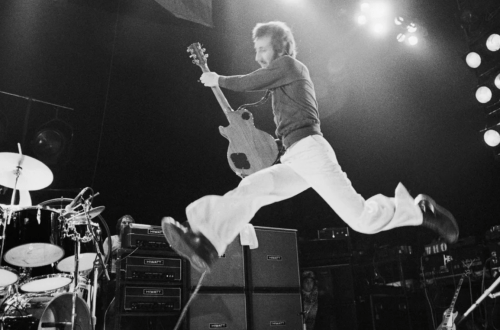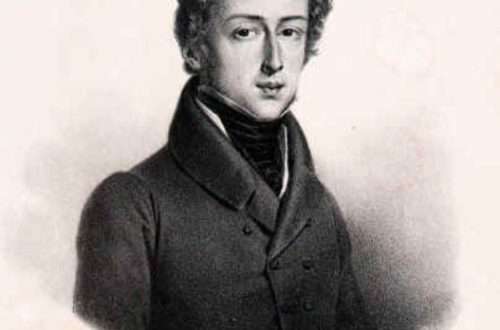
How Kurt Cobain modified his guitar
I recently started listening to Nirvana and noticed that the sound of the guitars in their songs is different from what you usually hear in modern bands. This is especially noticeable at the beginning of the song “Rape Me”.
I’m not very musically savvy and would be very grateful if someone could explain how Kurt Cobain modified his guitar to get such a unique sound?
Have other band members besides Kurt made similar modifications to their instruments to achieve this effect? If so, which ones?
Matthew Russell : For starters, it’s worth noting that for most of its existence, Nirvana was an unknown and poor band. Therefore, they tried to save as much as possible on the purchase of equipment. Their instruments were good but not impressive quality and most likely used.
Kurt has played a variety of guitars throughout his life. He was often seen with a Stratocaster made by Fender.
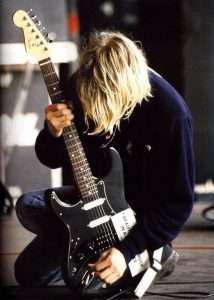 Kurt with a Fender Stratocaster | 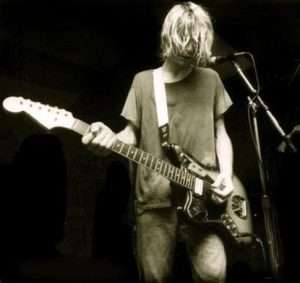 Kurt with a Fender Jaguar guitar | 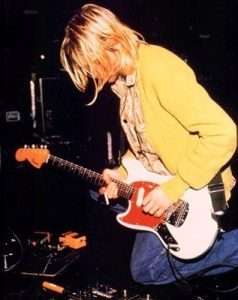 Kurt with a Fender Mustang |
The most famous Jagstang guitar, which combined the qualities of Jaguar and Mustang guitars. She is depicted in the picture below, which was made by Cobain:
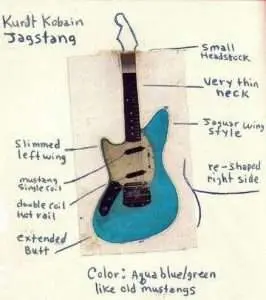
He also used other guitars, such as Univox, a copy of Mosrite. This proves that any guitar can sound like a Kurt Cobain guitar if played by Kurt Cobain. Guitarists often say that it all depends on who plays the guitar, and to some extent this is true.
Jaguar and Mustang guitars were not very popular at the time, as all the bands were trying to imitate such giants as Van Halen or Guns & Roses, who used completely different brands of instruments. It was for this reason that used Fender guitars could be bought at a very low price.
The main modification that Kurt made to his guitars was to install a humbucker instead of standard single coils. The sound produced with humbuckers is usually more powerful, fuller and has a pronounced emphasis on the mids. They are twice the size of single coils (compare the size of the black humbucker on a Stratocaster with the two regular white pickups in the pictures above), so putting a humbucker on a guitar designed for single coil use would require the top guard to be removed from the guitar’s body, or even cut the deck itself.
Such a modification was done to Kurt’s Jaguar (pictured above), but it was not done by him, but by the previous owner of the guitar. Sometimes Kurt used Seymour Duncan Hot Rails pickups – these are humbuckers reduced to the size of a single -coil . They could be installed on Fender guitars without any problems. He also used Seymour Duncan JB pickups when the guitar design allowed it.
To get this sound, Kurt modified not only the guitars, but also other equipment. I found information that Cobain was not serious about the choice of equipment and used very different components. On tour, his standard equipment was a Mesa Boogie preamp and separate low-frequency amplifiers. This system caused a lot of problems for the tech team, who were desperate to convince Kurt to use something more reliable.
He also used a BOSS DS-1 and DS-2, Distortion effects pedals , and a 1970 Electro Harmonix Small Clone chorus pedal. With their help, he achieved a “floating” sound, as, for example, in the song “Come As You Are”. Distortion pedals are footswitches that are usually connected between the guitar and the amp.
They are used to abruptly transition from a quiet “clean sound” to a loud, aggressive “dirty sound”, as in the intro to “Smells Like Teen Spirit”. They can also be used to produce a consistent “dirty sound” no matter what amp the guitar is connected to.
The BOSS DS-1 pedal can be seen in the foreground of the photo below. I can explain to you how Kurt got that guitar sound, but I have no idea how he does this headstand while playing one of his modified Stratocasters.
Various techniques used during recording also played a role. For example, the location of a microphone in a studio could affect the sound quality. Steve Albini, who helped record the In Utero album, recorded the bands in one take, playing in a room with several microphones . This technique allows you to get a “raw” sound that can not be achieved by other methods, for example, when the band members are recorded separately.
Kurt’s playing technique, or rather lack of it, also influenced the final result. This brings us back to the theory that everything depends only on the guitarist himself. Cobain was capable of many things, but he was not a virtuoso guitarist. In his playing, he put more feeling than skill: he hit the strings hard, getting a unique sound. He did not try to play in the same key with the other members of the group or constantly hit the notes – all this was reflected in the sound of his guitar.
Cobain used the “wrong” equipment and played very aggressively. He was inspired by styles such as punk and alternative, as well as popular rock at the time, so he did not want his guitar to sound “clean”, without any defects. He was using equipment that couldn’t produce high quality sound even if Kurt wanted to. Cobain worked with a producer who was also not interested in a “good” sound, so he helped the musician amplify the aggressive sound of the guitar using various recording methods.
Leon Lewington: Here’s a great interview in which Kurt explains how he got such a unique sound: “Kurt Cobain on gear and more in his latest interview with Guitar World magazine.
No one in the band paid much attention to how their instruments were tuned. Everyone just tuned in to Kurt’s guitar. He didn’t worry about the condition of his guitars either , how they were tuned or what condition the strings were in.
Dylan Nobuo Little: In short, it was several factors that made his music so unique. First, he used guitars that weren’t meant to be played (Kurt preferred Fenders that weren’t built for punk rock and Distortion pedals , and the Jaguar, with which Cobain is often associated, was built for surf rock).
Secondly, the tonalities he played and the more powerful humbuckers (they pick up the mids better and are considered warmer and fuller) created a unique sound . The sound was also influenced by the equipment used and Kurt’s playing style (which was very atypical). Now let’s move on to describing all the guitars he played (in chronological order) and the other equipment he used.
Kurt was left-handed, and despite the fact that right-handed guitars are cheaper and easier to find, he tried to play left-handed guitars as often as possible, as they were more suitable for his aggressive playing style. However, he occasionally used modified right-handed guitars with reordered strings, especially at a time when Nirvana was still a garage band and it was difficult for them to get the necessary equipment.
During this period, Kurt used a lot of used equipment (mostly Fender and Gibson copies), including Mosrite Gospel, Epiphone ET-270 and Aria Pro II Cardinal, which became his spare guitars. The most famous guitar of this period was the Univox Hi-Flyer, a copy of the Mosrite Mark IV with a light weight and unique body shape that Kurt continued to use even as Nirvana became a popular band. Throughout his career, he has acquired and modified numerous guitars.
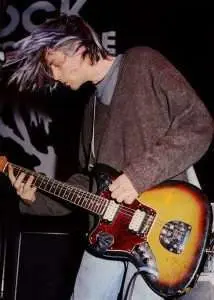
Beginning around 1991, Kurt preferred to play Fender guitars. After the release of Nevermind, he performed with a heavily modified Fender Jaguar ’65 sunburst guitar that featured a red mottled pickguard. Now Jaguar guitars, and similar Jazzmaster guitars, are very expensive, but at that time these American models could be bought at a fairly low price. Kurt bought his guitar for about $500 at LA Recycler.
It has already been modified by the previous owner (Martin Jenner of Cliff Richard and The Everly Brothers). He fitted it with dual Dimarzio humbuckers (a PAF-type neck pickup and a Super Distortion bridge ), a Schaller Tune-o-Matic bridge like on Gibson guitars, and a second volume control.
He got used to this set of elements and continued to modify his Fender guitars in the same vein. He then replaced the standard pickup select switch (3-position switch) with a three-way push-button switch. Prior to this, he used duct tape to keep the switch from accidentally changing its position, as he mainly used a left bridge pickup .
Later, after recording In Utero, he replaced the Super Distortion humbucker with his favorite Seymour Duncan JB. It is also worth noting that he never used the tremolo arms and fixed their tailpieces, increasing the sustain and precision of the guitar’s tuning. What’s more, all of his guitars had Schaller strap mounts, and Ernie Ball straps were either black or white.
He always had several Fender Stratocasters on hand (mostly white or black, but one was sunburst and the other red), which were broken during the band’s famous concerts. They were assembled either in Japan or Mexico and were cheap alternatives to American models.
He put a JB humbucker on all of these guitars. Sometimes it was a ’59 Seymour Duncan or when a big humbucking Hot Rails couldn’t fit on a Strat . After the Strats were smashed, new guitars (“Franken-Strat”) were assembled from their parts. An example of such a guitar is an all black Strat guitar (with black body, pickguard, ’59 pickup and controls, and a Feederz decal) with a Fernandes Strat neck (the original neck was broken).
This neck only lasted a month and was replaced with a Kramer neck (the band carried them around all the time for repairs). Kurt probably liked them better than Fernandes ‘ necks (although they were the easiest to get). All the other necks on his Fenders had rosewood fretboards, which he liked more than maple .
During the In Utero tour, Kurt’s main guitar was a Fender Mustang. He owned several of these guitars, one in “Fiesta Red” with a spare pearl white pickguard and black pickups, and two others in “Sonic Blue”. They differed only in appearance – one had a mottled red pickguard and white pickups, and the other had a matte red deck top and white and black pickups.
The stock bridge has been replaced with Gotoh’s Tune-o-Matic and the pickup next to it has been replaced with a Seymour Duncan JB. As with the Jaguar guitar, he did not use neck pickups (apart from some studio recordings) and tremolo arms . The tremolo springs have been replaced with conventional washers, and the tailpiece has been fixed so that the strings pass through it directly. This system is more typical for Gibson guitars.
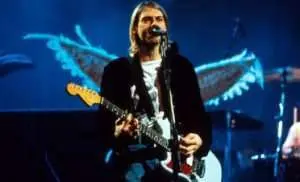
Kurt also began working with Fender to create the Jag-Stang, a combination of Jaguar and Mustang guitars that combined his favorite qualities: a Tune-o-Matic bridge, a left humbucker bridge , short length (short 24″ scale ) and a unique shape. the guitar itself. However, he only used this guitar a few times towards the end of his career – Kurt remained faithful to the Mustang guitars. It is worth noting that the entire group tuned their instruments lower by half a step.
For acoustic performances, Kurt used either an Epiphone Texan guitar with a detachable Bartolini 3AV pickup (easily identified by a “Nixon Now” sticker) or a very rare 1950 Martin D-18E guitar. It can be heard on the Unplugged In New York album, but as an electro-acoustic (with a Bartolini 3AV pickup, but already built into the guitar itself), which he connected through pedals and a mixer , so it cannot be called purely acoustic.
Both of these guitars were modified right-handed models with reordered strings. The funny thing is that the guitar he played during the recording of the songs “Polly” and “Something In The Way” from the Nevermind album was in very bad condition, but he did not modify it in any way or even change the strings on it. It was a 12-string Stella Harmony that he bought for $30 at a pawnshop. She had only 5 nylon strings, and the bridge was held on with glue.
As a true collector of mostly old, unusual and cheap instruments, Kurt consciously avoided buying new equipment. I didn’t mention the sheer number of other guitars he played: a couple of modified Telecaster guitars and other Mustangs (mostly the ’69 model known for its appearance in the “Smells Like Teen Spirit” video). Mosrite Mark IV and Fender XII guitars (both destroyed along with home recordings and diaries that Kurt hid in his bathroom to protect from robbers – they were flooded with water).



